
The federal government ‘sees a long-term future for the oilsands.’ Here’s what you need to know
An internal document obtained by The Narwhal shows how the natural resources minister was briefed...
Get the inside scoop on The Narwhal’s environment and climate reporting by signing up for our free newsletter.
The northwest Montana prairie rests like a golden blanket over the uneven plateau, until it falls away suddenly over an unseen cliff. It’s easy to imagine how a stampeding herd of buffalo could be fooled into running straight over the precipice — and that’s exactly what they did for eons, feeding generation after generation of the Blackfoot who orchestrated their gravity-assisted demise.
Tyson Running Wolf, state representative and member of the Blackfeet Tribe, (one of four members within the Blackfoot Confederacy, whose territory extends across the Canada-U.S. border) stands at the top of the cliff and pictures what it would have looked like when hundreds of his ancestors worked in synchrony to hunt buffalo, the single most important species known to them and to the plains themselves.
“Beautiful, isn’t it?” he says.
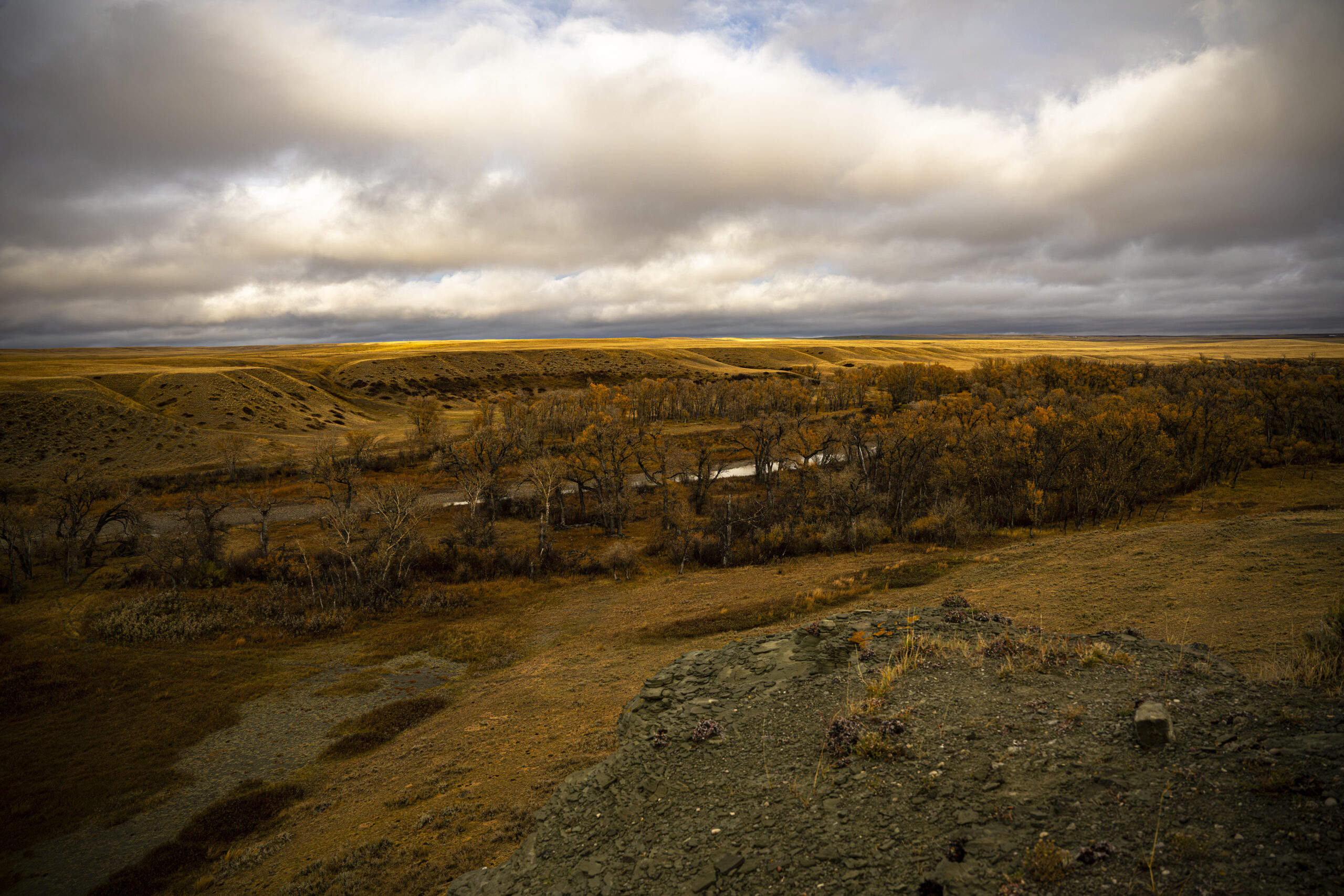
What’s left now in the archaeological record is enough to establish a long pattern of use and occupation; across the creek from the buffalo jump is a campsite dated to the 14th century. In satellite images, dozens of ancient stone tipi rings stand out like cup rings on a bar top.
On the slope below the cliff, what looks like coarse gravel is a layer of buffalo bone fragments so thick it could be mistaken for a geologic epoch. At its base, there’s a stratum of ash, from where the Blackfoot burned the prairie. Above that is bone from the buffalo that moved in to graze on the new growth that flourished in the cleared and fertilized ground. On top is a layer of dust, accumulated over the centuries since the last great buffalo jumped from this cliff.
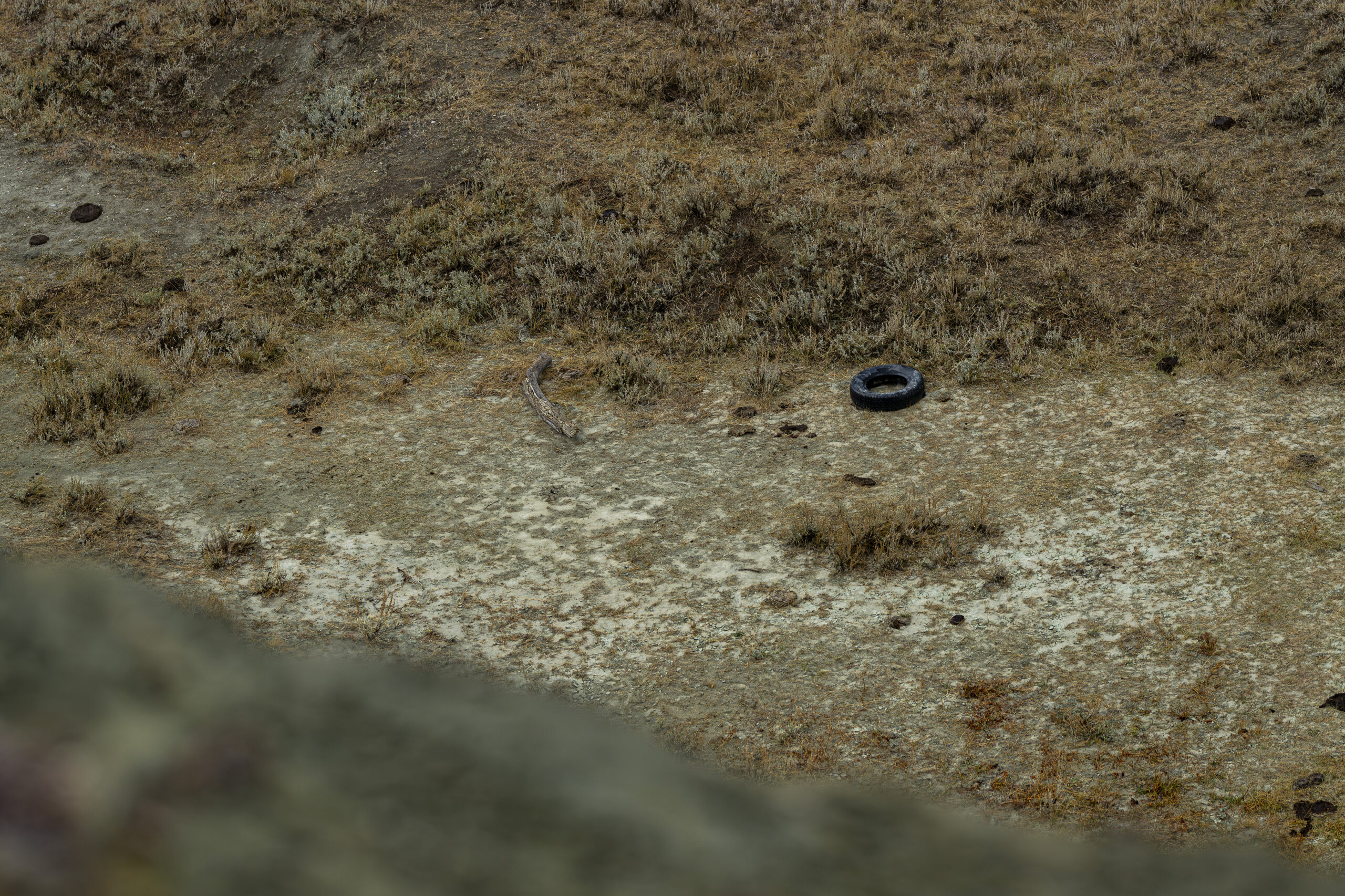
A few kilometres away, a buffalo herd is meandering across a wide-open field. They’re carefully monitored by a select group of tribal members, occasionally harvested for cultural feasts and buttressed in their genetic makeup with inflows and outflows to and from other growing herds across the plains.
But they also have a deeper purpose, one that could herald a stunning cultural revival: the Blackfeet are working toward a time when they can run the buffalo over the cliff once more.
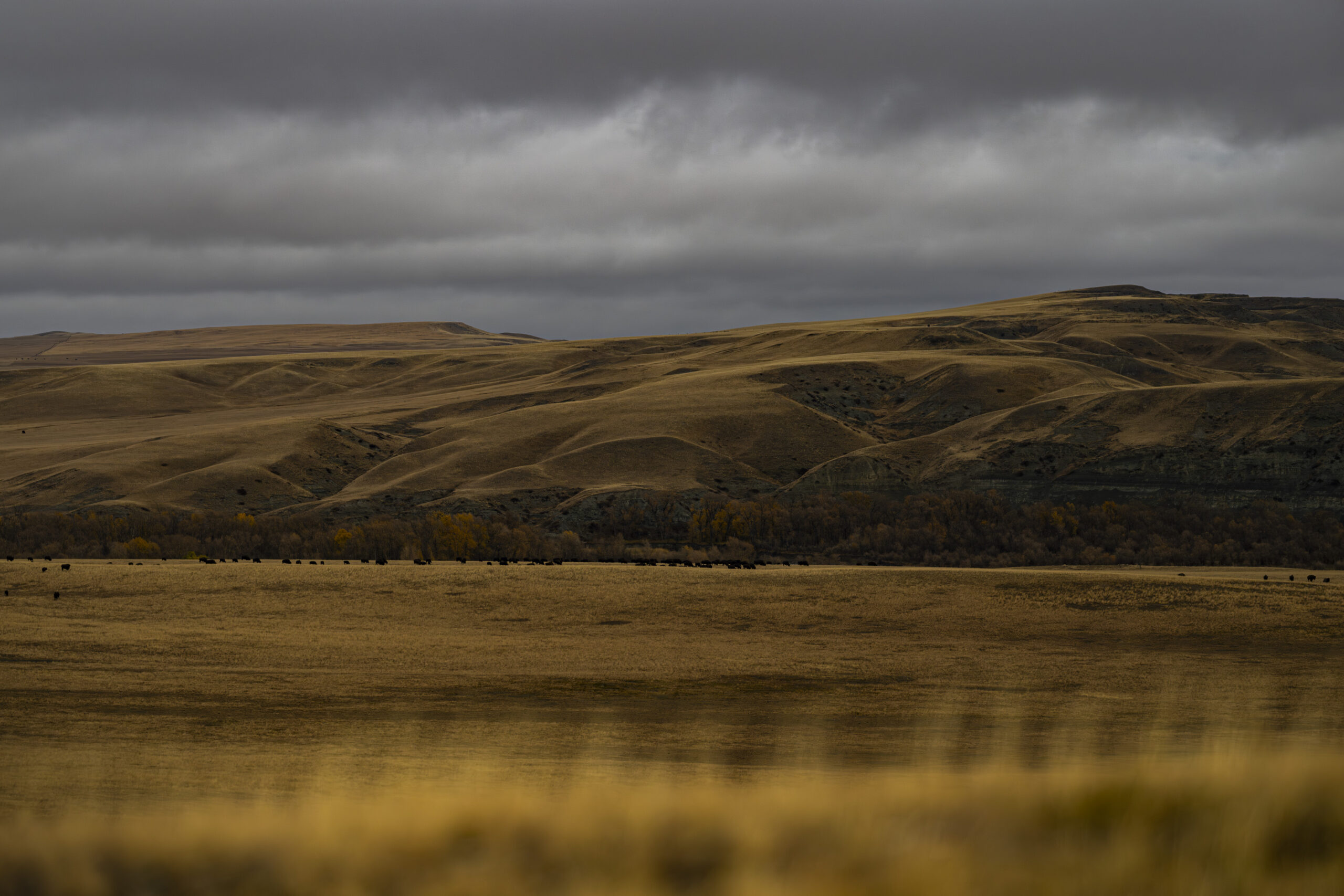
Work to support Indigenous Guardians programs in Canada has provided something of a blueprint for this effort. But without dedicated government funding and a lack of a clear regulatory framework, the Blackfeet are forging a new path in Montana with implications that will reverberate across the Canada-U.S. border — one that could mean free-roaming buffalo again cross the border as they once did, as though it doesn’t exist at all.
Unfathomable numbers of buffalo (“a ‘bison’ is what an Australian washes his face in,” Blackfeet Elder John Murray jokes) once moved across this landscape. As many as 60 million may once have roamed the continent between northern Mexico and Great Slave Lake, and east of the Rocky Mountains, according to anthropologist María Nieves Zedeño. Those numbers were run into the ground as part of a strategy to clear the plains and starve the Indigenous Peoples who depended on them.
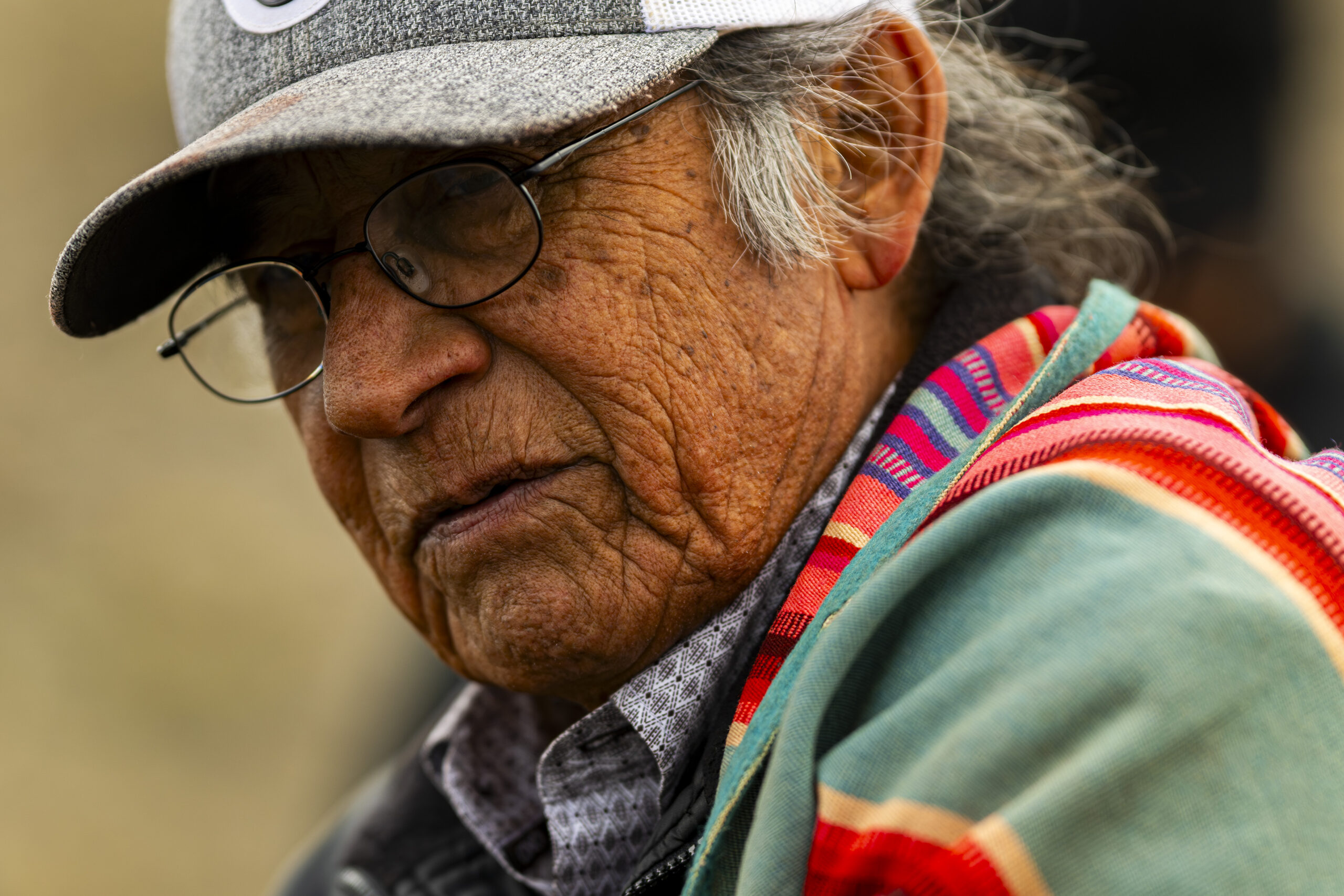
“I would not seriously regret the total disappearance of the buffalo from our western prairies, in its effect upon the Indians, regarding it as a means of hastening their sense of dependence upon the products of the soil and their own labours,” Columbus Delano, Secretary of the Interior, wrote in his 1873 report to Congress, referring to the trend of settlers trespassing on reservations “solely for the purpose of hunting buffalo, which are thus destroyed in large numbers.”
A contemporaneous Smithsonian Museum report estimated that in the three years between 1872 and 1874 (a period referred to in the report as the “great slaughter”) more than three million buffalo were killed by settlers. Half, it noted, were wasted. At the height of the extermination effort, Zedeño says, as many as 180,000 buffalo hides were floated down the Mississippi River alone each year.
But in one of the greatest ecological comebacks of all time, the buffalo are returning — and Indigenous communities are once again in the middle of it all.
In 1889, the Smithsonian report estimated there were just 891 wild buffalo left in all of North America. Today, at around 400 animals, the Blackfeet-owned herd is approaching half the total number of buffalo that were left when the deliberate process of extermination wound down at the end of the 19th century. And soon, they expect their herd will far surpass that number.
A buffalo run took hundreds of people to move the herd, guide it along its path, funnel the stampeding animals toward the cliff and slaughter them at the bottom while corralling the surviving animals. Likewise, managing their return is a huge and multifaceted endeavour that requires a host of specialized skills and a dedicated group of people.
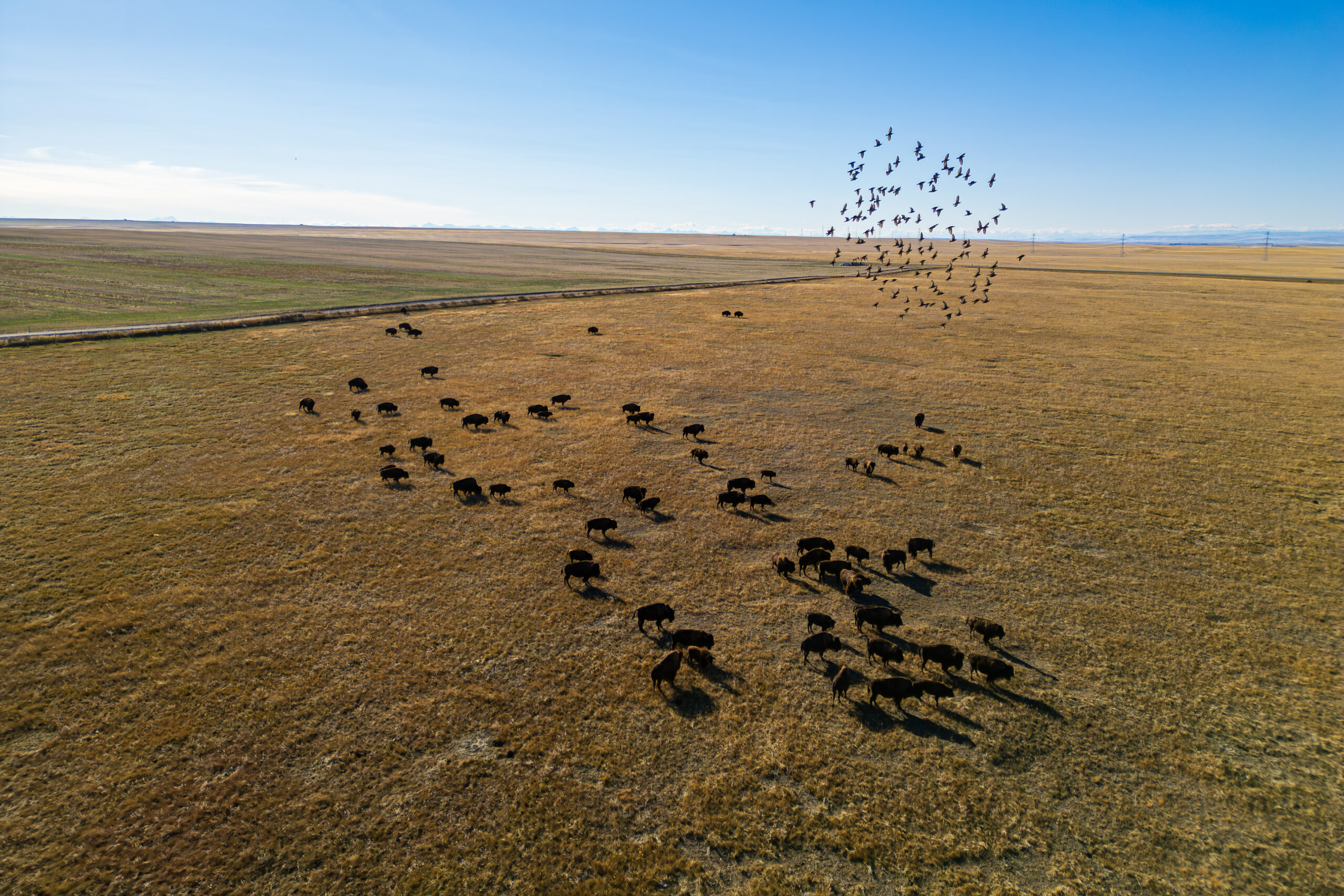
Running Wolf found inspiration for what would become that group on a trip to the Heiltsuk Nation, on the central coast of B.C., in 2018.
The Haíɫzaqv (Heiltsuk) are among the earliest First Nations to build a modern Guardians program, monitoring and stewarding their traditional territory. Running Wolf saw the nation had the answer to a question he’d been pondering since he was studying forestry at the University of Montana.
Back then, he’d felt like his scientific and academic training was missing something essential.
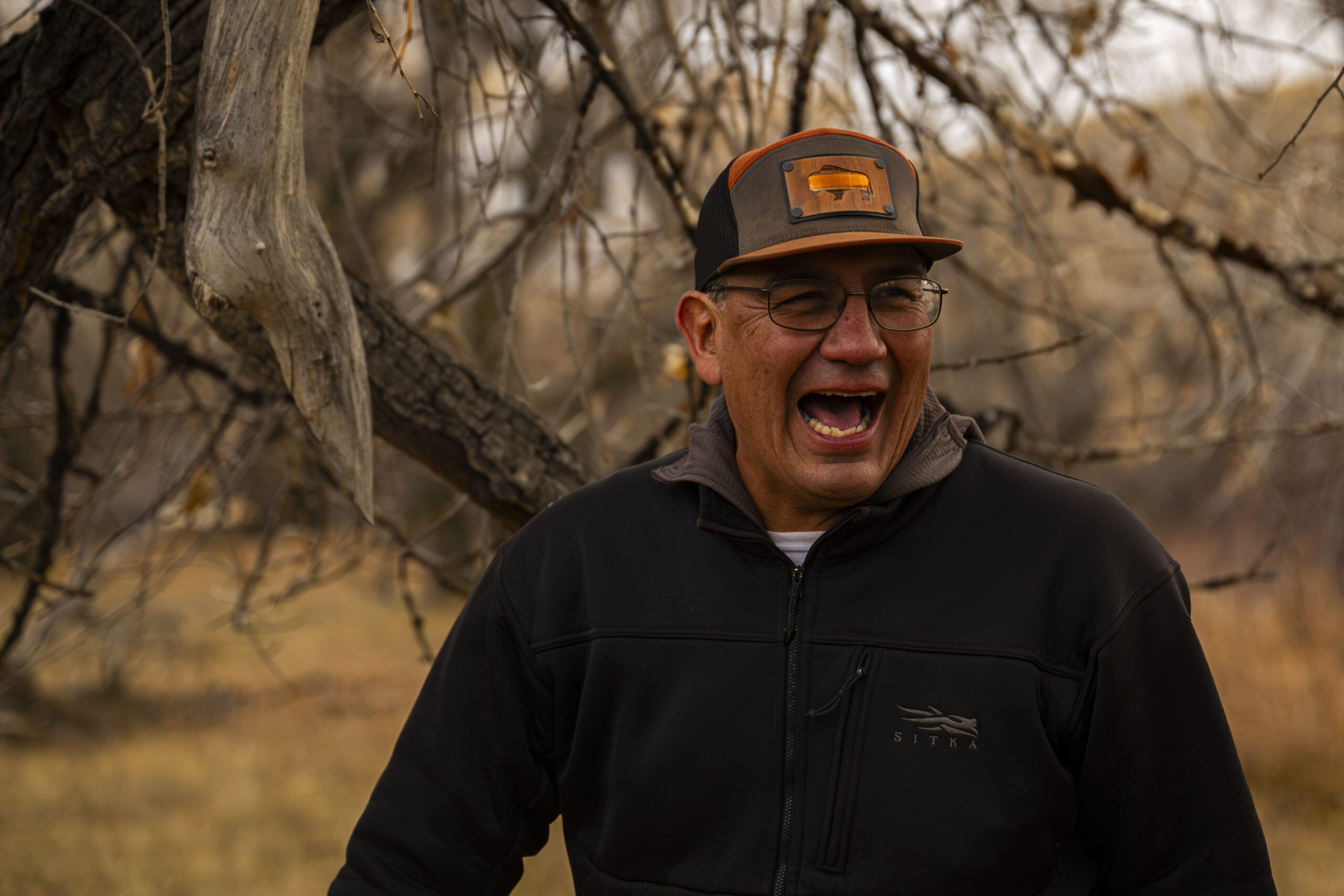
“All I’m doing is just practising what the white man wanted us to learn and just keep perpetuating being a colonizer,” he realized. The Coastal Guardian Watchmen of Haíɫzaqv had a different approach: blending the tools of western science with the knowledge of his people. That, he realized, was what he wanted for the Blackfeet. The Shield Keepers were born. There are four in the crew now, working, Running Wolf says, “to help make both worlds work together in harmony for the betterment of the environment, animals and people.”
The role is particularly clear when it comes to the buffalo.
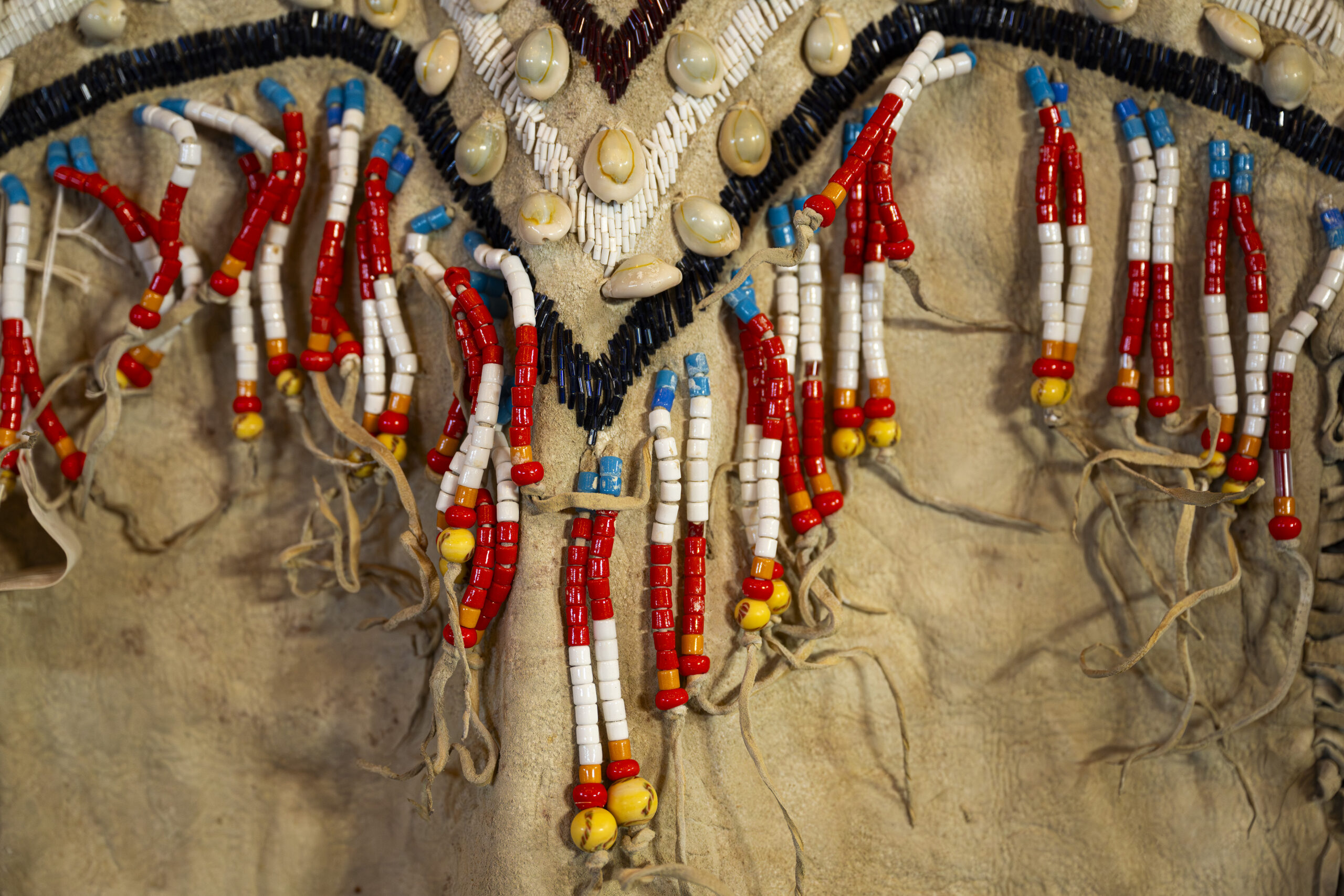
“That guardian is a conduit between the buffalo and the human,” Running Wolf says. “To make management decisions and social decisions amongst ourselves so that the buffalo can flourish and [we] can flourish, together.”
And Darrell Hall is the conduit between the Shield Keepers and the tribe’s herd of buffalo.
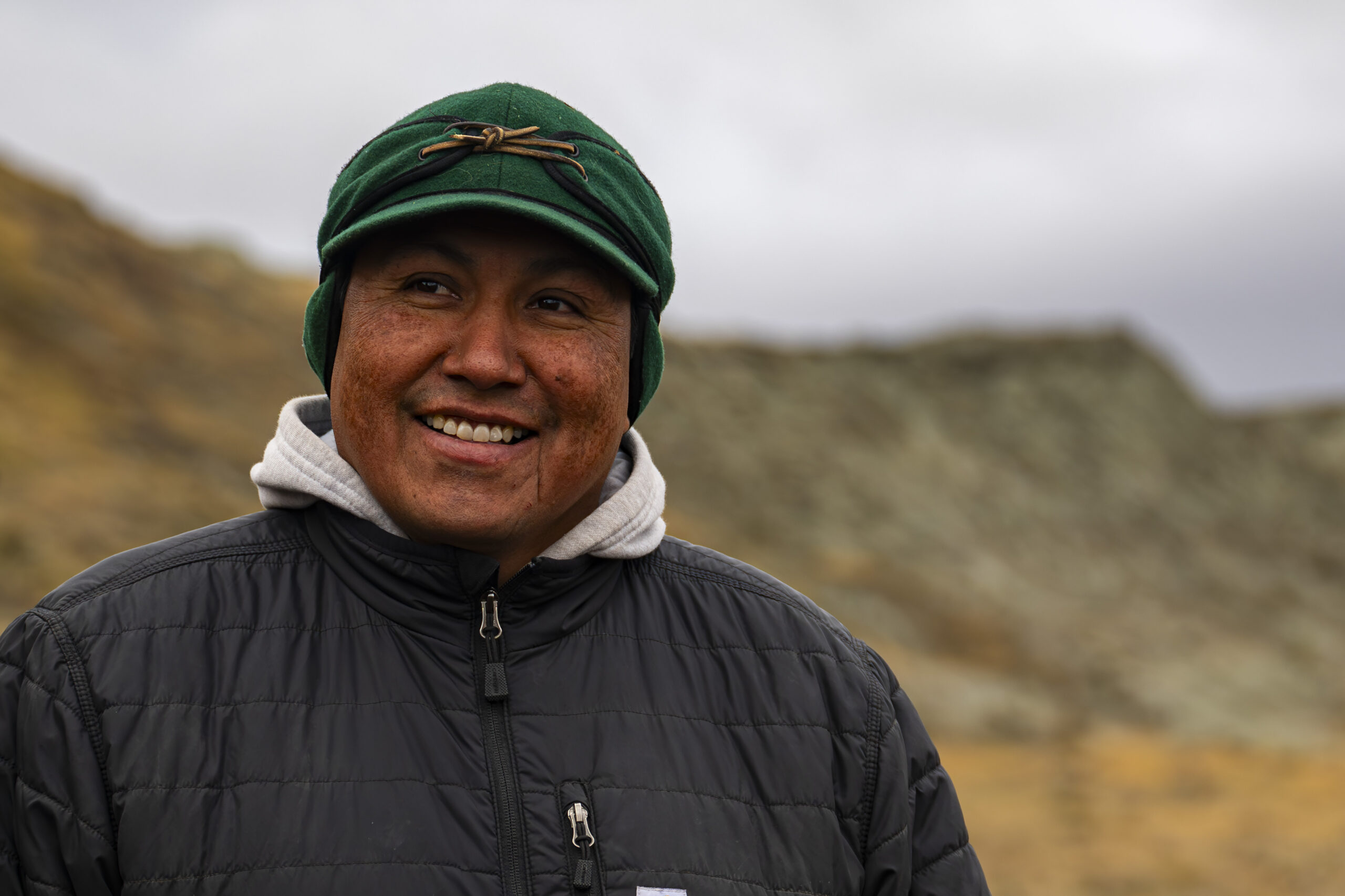
“Just about anything that takes place with the buffalo, I’m there,” he says. That goes beyond what a typical caretaker of a ranch might do, from herding to culling, and veers into the spiritual realm. “We always include the iinii [buffalo] in our prayers — that they come back like we did. They were near extinction, just like the Blackfeet were.”
But a much more practical consideration dogs the Shield Keepers: the buffalo habitat is fragmented, and rebuilding it will require purchasing land.
Unlike Indigenous Guardians programs in Canada, many of which now receive government funding, training, support and, recently, even official delegated authority, the Shield Keepers are starting from zero: no dedicated state or federal government funding, no established network, no regulatory framework. Unlike in Canada, where guardians have become legislated parts of the parks system at the federal and provincial levels to varying degrees, the United States has no such multi-level cooperation.

Canada has more than 200 Guardians programs across the country, from coast to coast to coast, with $100 million pledged in federal funding. The United States has significantly less in the way of established programs and funding.
“Canada’s light years ahead of the U.S.,” says Chuck Striplen, who works in Indigenous stewardship for the California-based Resources Legacy Fund. Striplen, who belongs to the Amah Mutsun Tribe, has watched — and participated — as states and the federal government have begun returning thousands of hectares of land to Native American tribes and establishing joint management programs for fire, wildlife, fisheries and more.
“It’s almost like the civil rights movement, trying to get the wider population to recognize history,” he says.
It doesn’t help that there isn’t a coordinated central advocacy and training body in the U.S. like the Indigenous Leadership Initiative, which focuses on Canada but which also works south of the border. Work in Canada and Australia is providing a blueprint for that coordination — and an inspiration for how big things can get. Looking at the Guardian Watchmen, Running Wolf and Hall see what the Shield Keepers could become, given the proper resources.
“They’ve received millions of dollars,” Hall says. “We’re just getting started.”
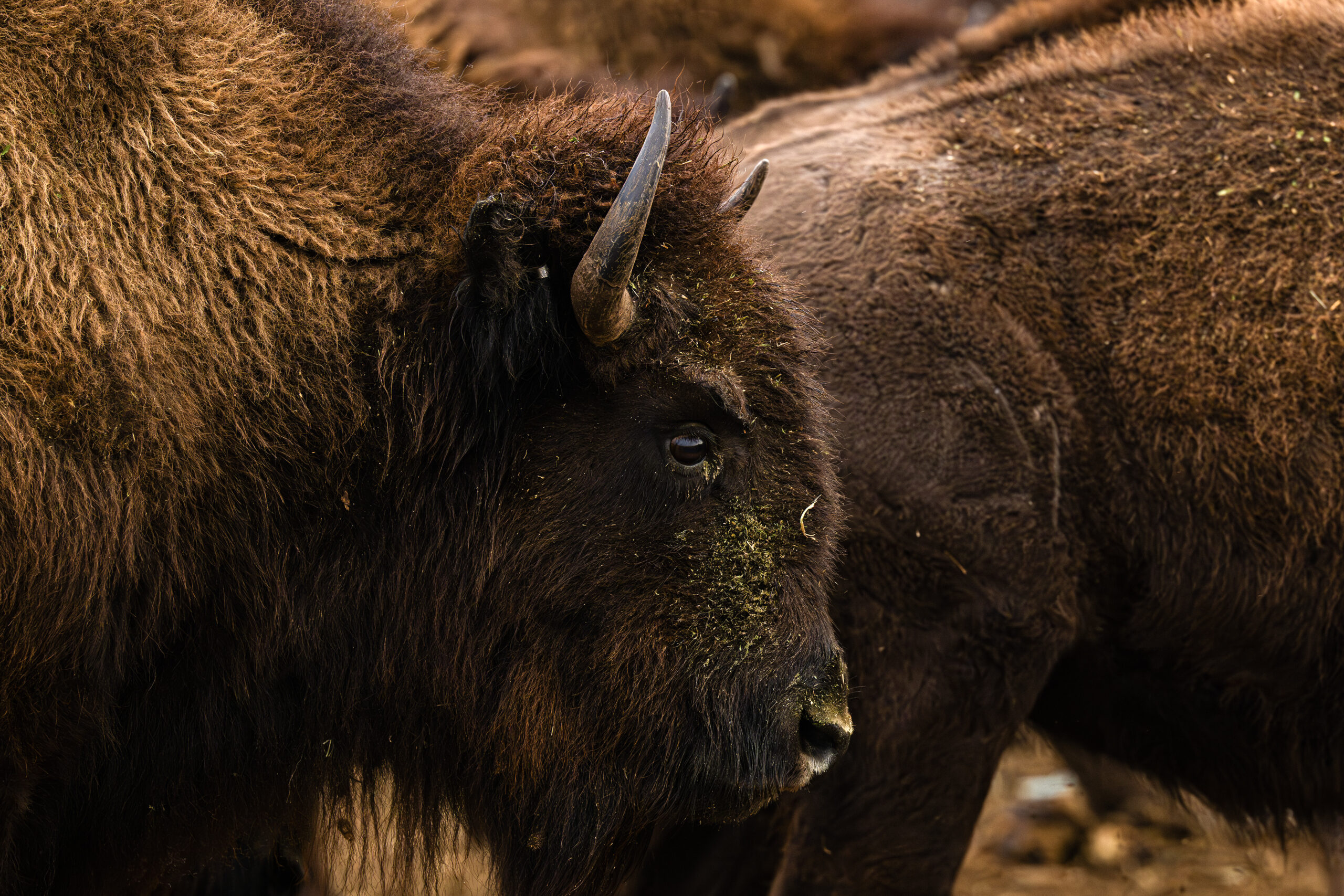
But a similar funding model may be available to the Shield Keepers as was available to the Coastal Guardian Watchmen since their early days: carbon credits, which provide money in return for protecting or maintaining ecosystems that remove carbon from the atmosphere. In B.C., the Great Bear Rainforest Agreement raises money through carbon credits based on the deferred logging in the rainforest. Some of that funding goes to the guardians, allowing them to pay for their boats, trucks, equipment and salaries.
The Shield Keepers are exploring a similar model. An agreement to sell carbon credits for deferred logging on the eastern slope of the Rocky Mountains, within Blackfeet territory, has already raised close to US$7 million. The Nature Conservancy, a global non-profit organization that operates in Canada as Nature United, helped to arrange the deal. It is encouraging the tribal leadership to direct that funding toward the Shield Keepers and land acquisition — particularly for the buffalo.
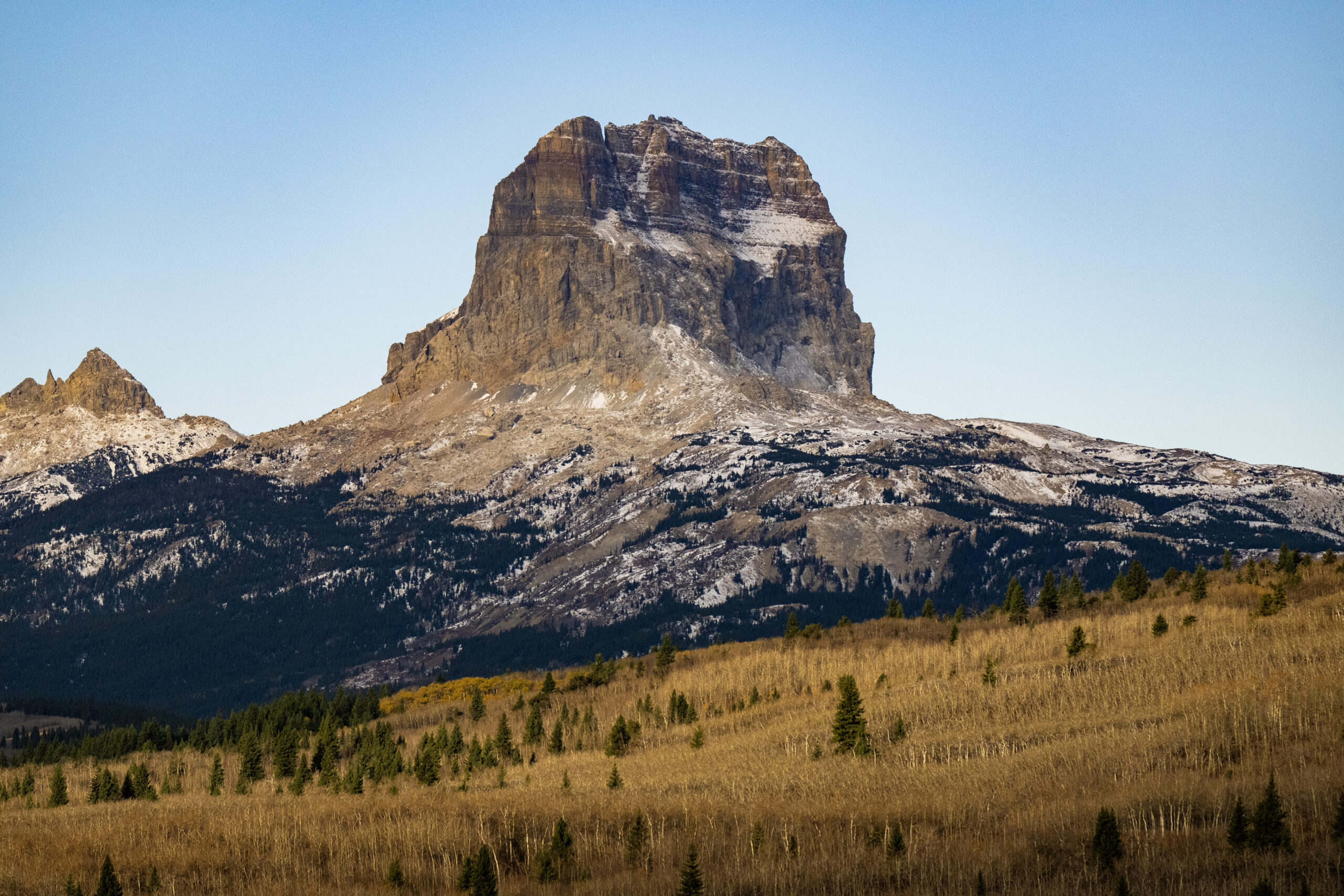
The current herd of 400 or so buffalo need more land to graze. The tribe hopes to someday steward a larger herd — Hall would like to see 6,000 buffalo on Blackfeet-owned lands one day, while Running Wolf pegs the goal at 2,000 — but the Shield Keepers have kept the numbers much lower through culls and sales to ranchers to prevent overgrazing. Adding more land is a complicated and expensive process, but it’s happening: on the front slopes of the sacred Chief Mountain, Hall says 17,000 hectares have already been set aside by the tribe.
Buffalo were re-established in the area in 2023, after Glacier National Park announced it had received US$1.5 million from the federal government to study the reintroduction of bison to the Eastern Slope area of the park, which includes Chief Mountain.
But those buffalo had to be corralled again after fears arose that they would move beyond the park and on to private property in southern Alberta — where they might be shot by ranchers fearful of brucellosis, a bacterial infection, or other diseases. (There have been no documented cases of brucellosis transmission from buffalo to cattle, but it’s not unlikely; buffalo are immune to the disease but can carry it.)
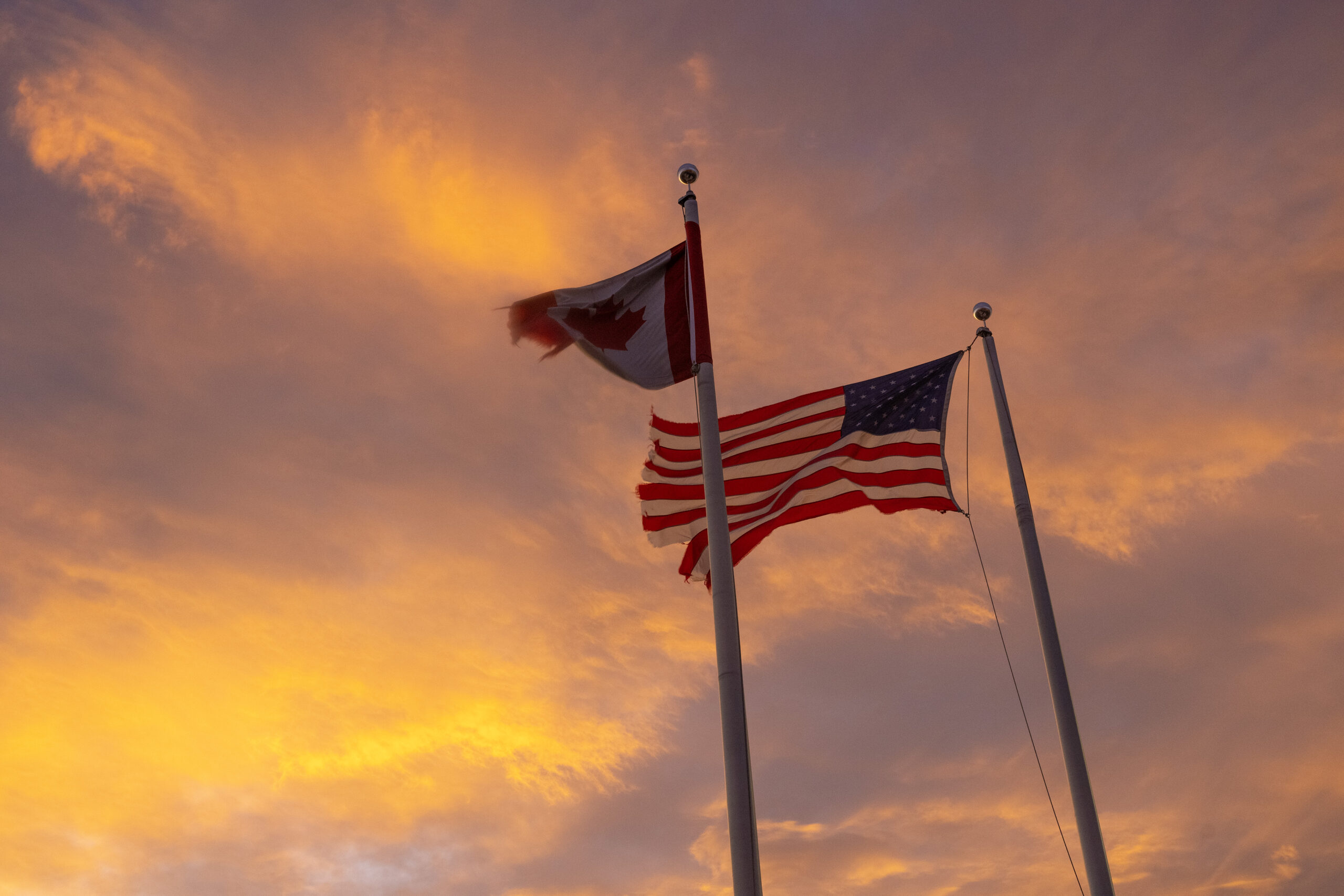
Now, the guardians are working with Canadian and American park officials to build fencing along the international border to keep the buffalo from wandering onto the ranches. Once that’s complete, the buffalo will be let out again, with the support of the park authorities.
“Everybody’s on board with the buffalo right now,” he says. “Wherever you go, it’s like, ‘the buffalo, the buffalo,’ so they’re making their way back.”
When birds line their nests with tufts of buffalo fur, their hatchlings have a higher likelihood of making it out of the nest alive. Ground squirrels use their fur for their nests as well. Buffalo wallows — picture an unusually tall and narrow Honda Fit rolling in the mud — create moist microhabitats that are preferred by insects and amphibians like frogs and salamanders. The trails buffalo make through the landscape are used by other species, including humans, because of their efficiency in connecting points of land through difficult terrain. Species richness as a whole has been found to increase after buffalo are reintroduced. For these reasons and countless more, buffalo are considered a “keystone species,” one whose presence — or absence — fundamentally alters the entire ecosystem of the prairies.
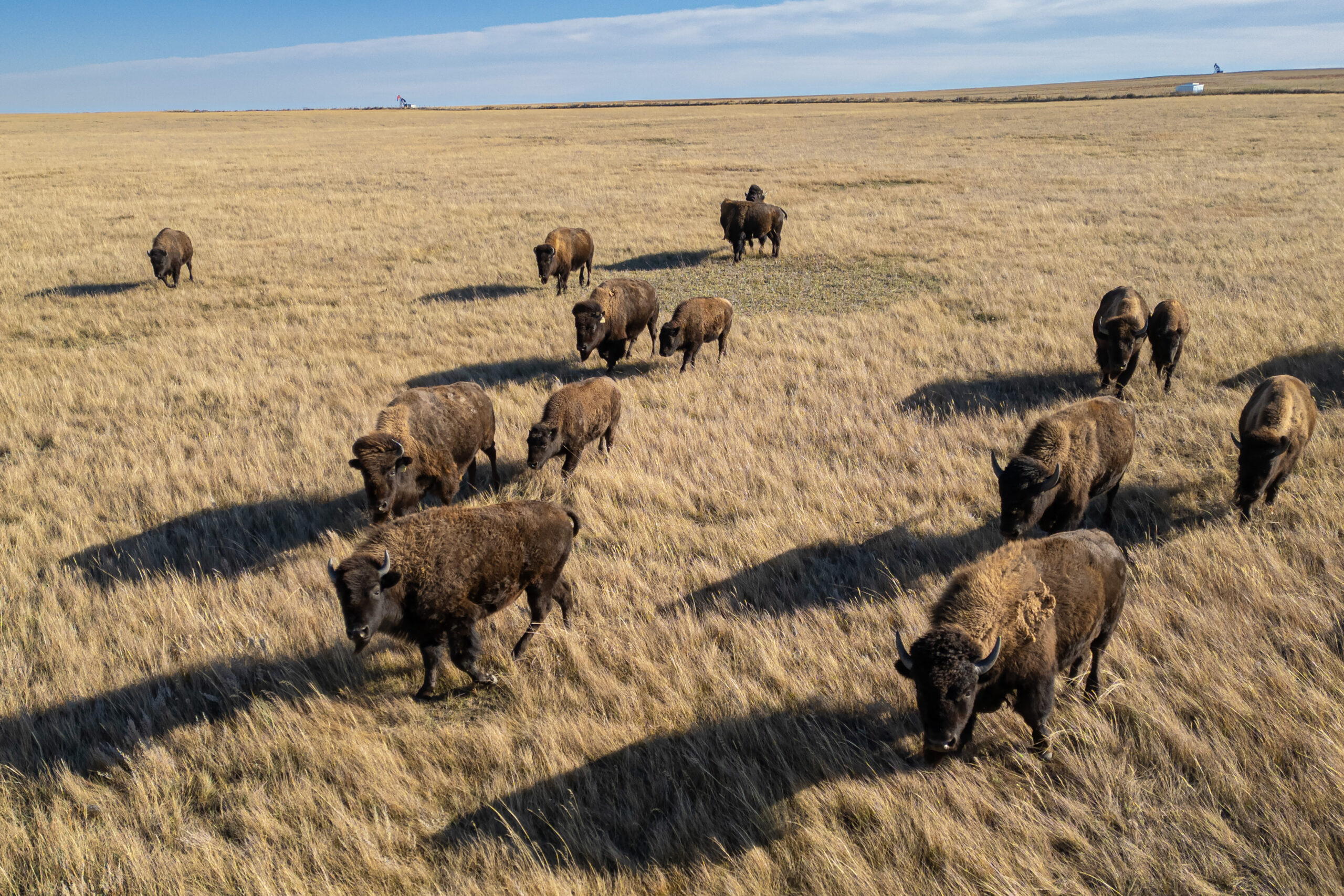
North of the border, on the Kainai Nation in Alberta, Kansie Fox and her team of six Kainai grassland guardians started monitoring the land before the buffalo were brought back, to measure the differences the animals make.
Fox is the environmental protection manager for the First Nation, which is also a member of the Blackfoot Confederacy. She ranks the buffalo program as her top priority, despite the breadth of her title.
“Along with buffalo is grasslands,” she says. “And we’ve been trying to protect our grasslands since day one. … We’re trying to keep this space intact as much as possible.”
“Intact” is a complicated notion for a landscape that depends on disturbance. An intact prairie landscape is not an untouched one — it’s one that’s been trampled and pooped on and burned and regrown and trampled all over again, Alvin First Rider, an environmental technician who is part of Fox’s team, explains.
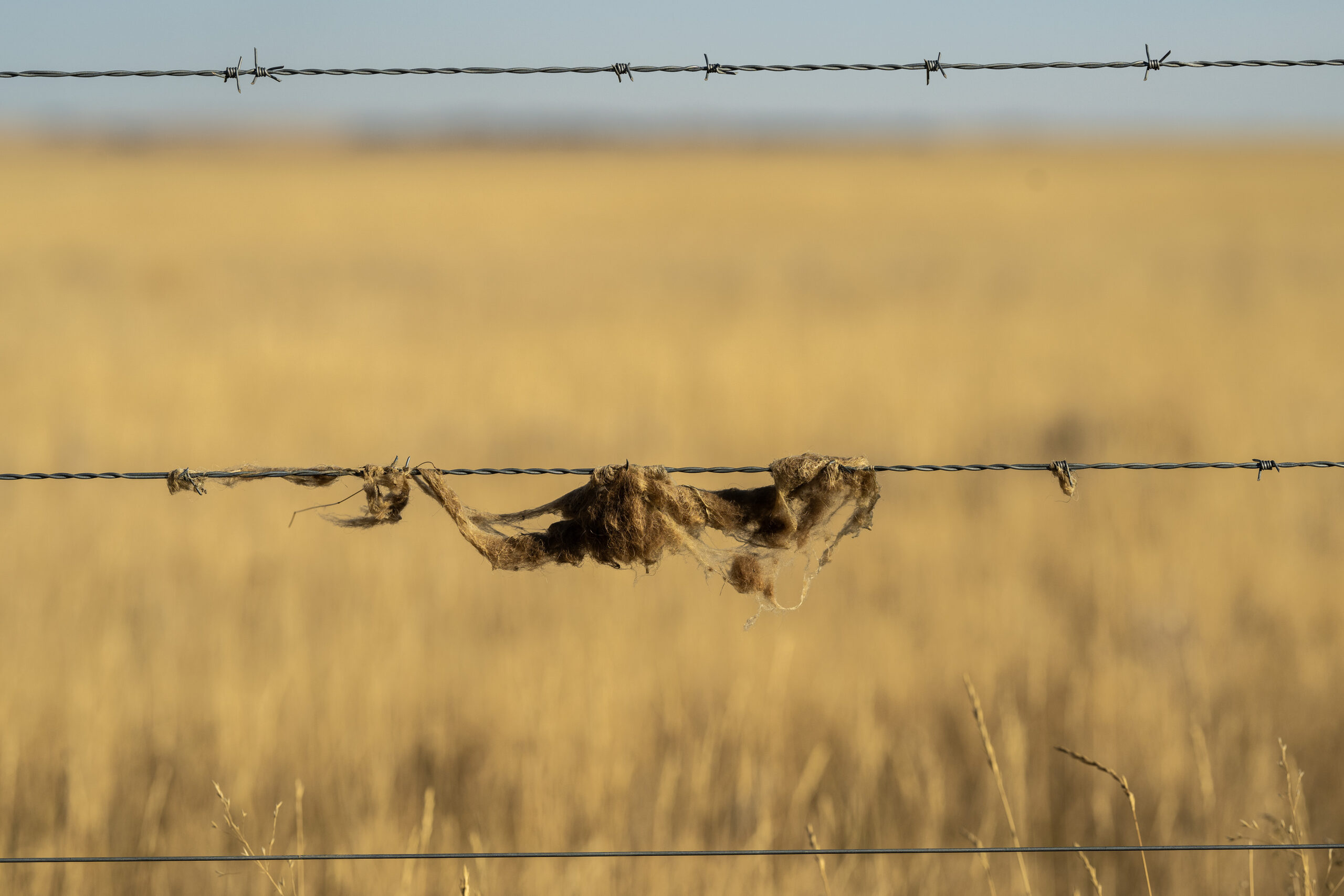
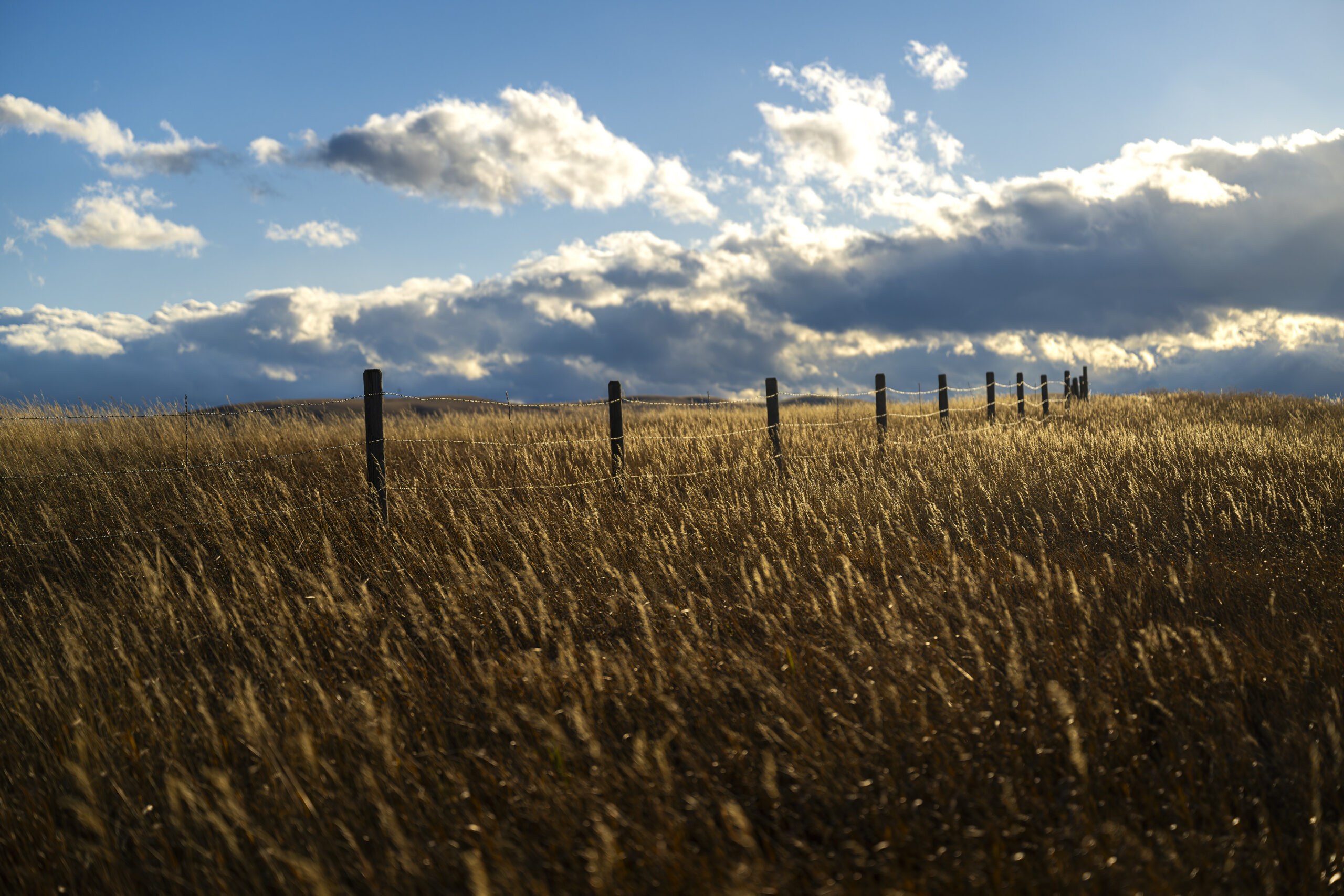
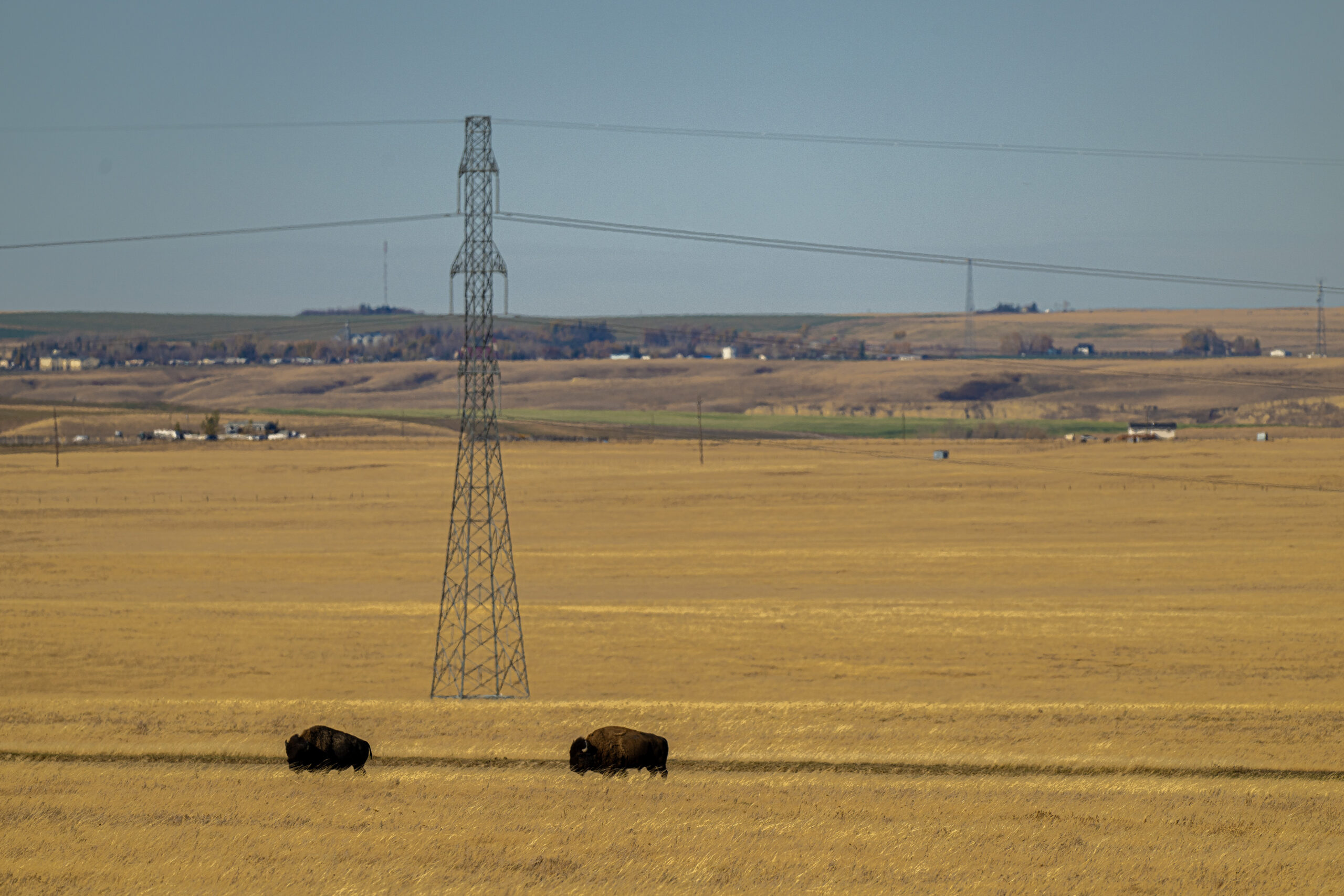
“Historically this area was managed through fire, that was what cleansed the earth. … Just like a flood on a river. The flood on a river is natural; it’s a huge disturbance but it’s natural,” he said. “We would burn one area and then move; it was a rotational burning and grazing.” That burning and grazing is what created the ash-bone pattern so evident on the hillside in Montana. The Kainai Guardians, formally established around 2018, have done a couple of cultural burns on the landscape. Then came the buffalo.
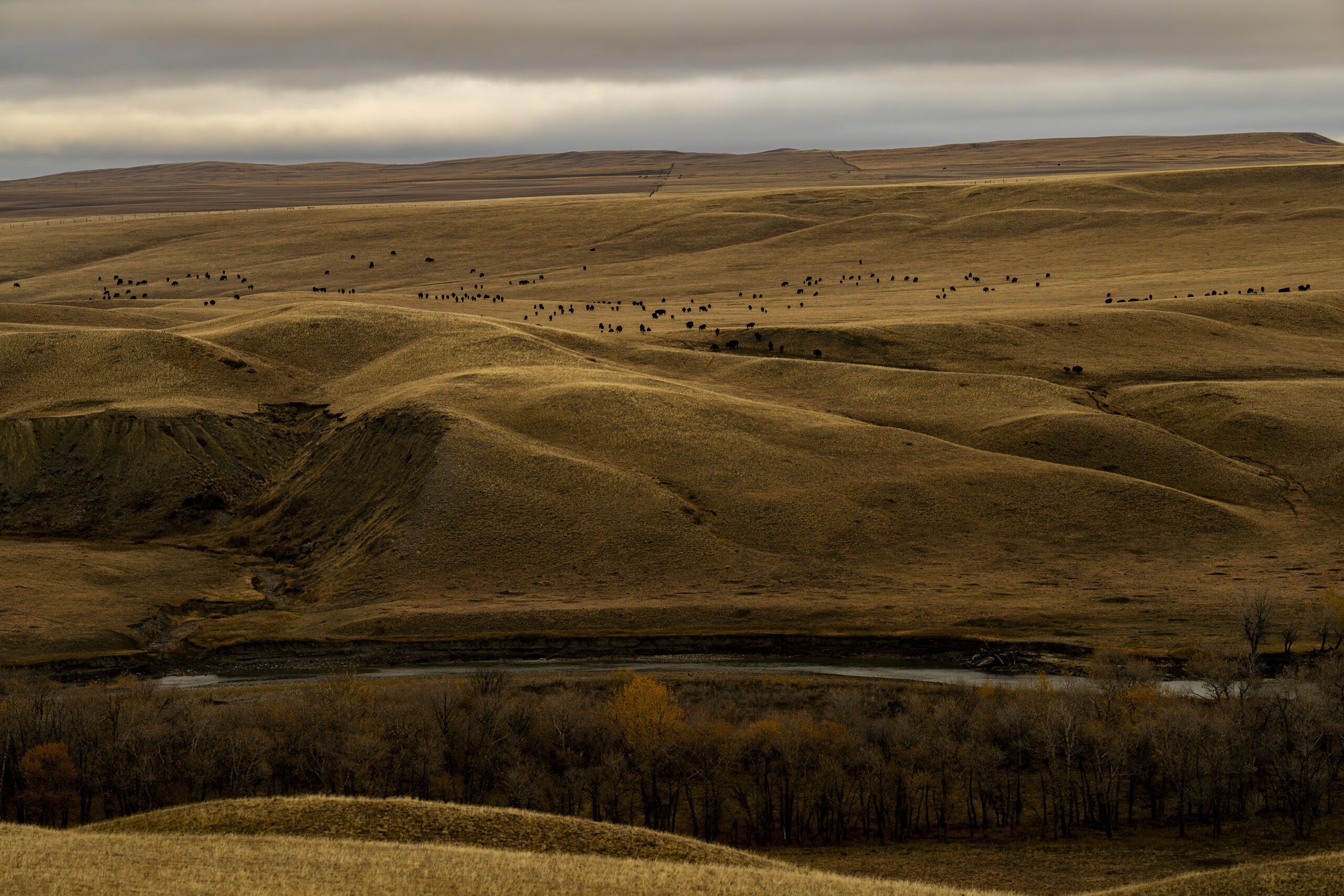
It’s been six years since 40 buffalo were let out on a pasture on the north end of the reserve, and the herd has since grown to nearly 80. Fox, First Rider and their colleague Truman Big Swallow have noticed an improvement in grassland bird species, but the landscape itself hasn’t seen major changes — something Fox counts as a win.
“Seeing major changes right now in, say, vegetation, would mean that we’re overgrazing,” she explains.
And a bigger, more significant change is already taking place. Fox is standing next to the backbone of a buffalo, left as an offering to the land after a buffalo was harvested here just an hour prior. It’s the fourth since September, when the first-ever buffalo was harvested from the Kainai herd.
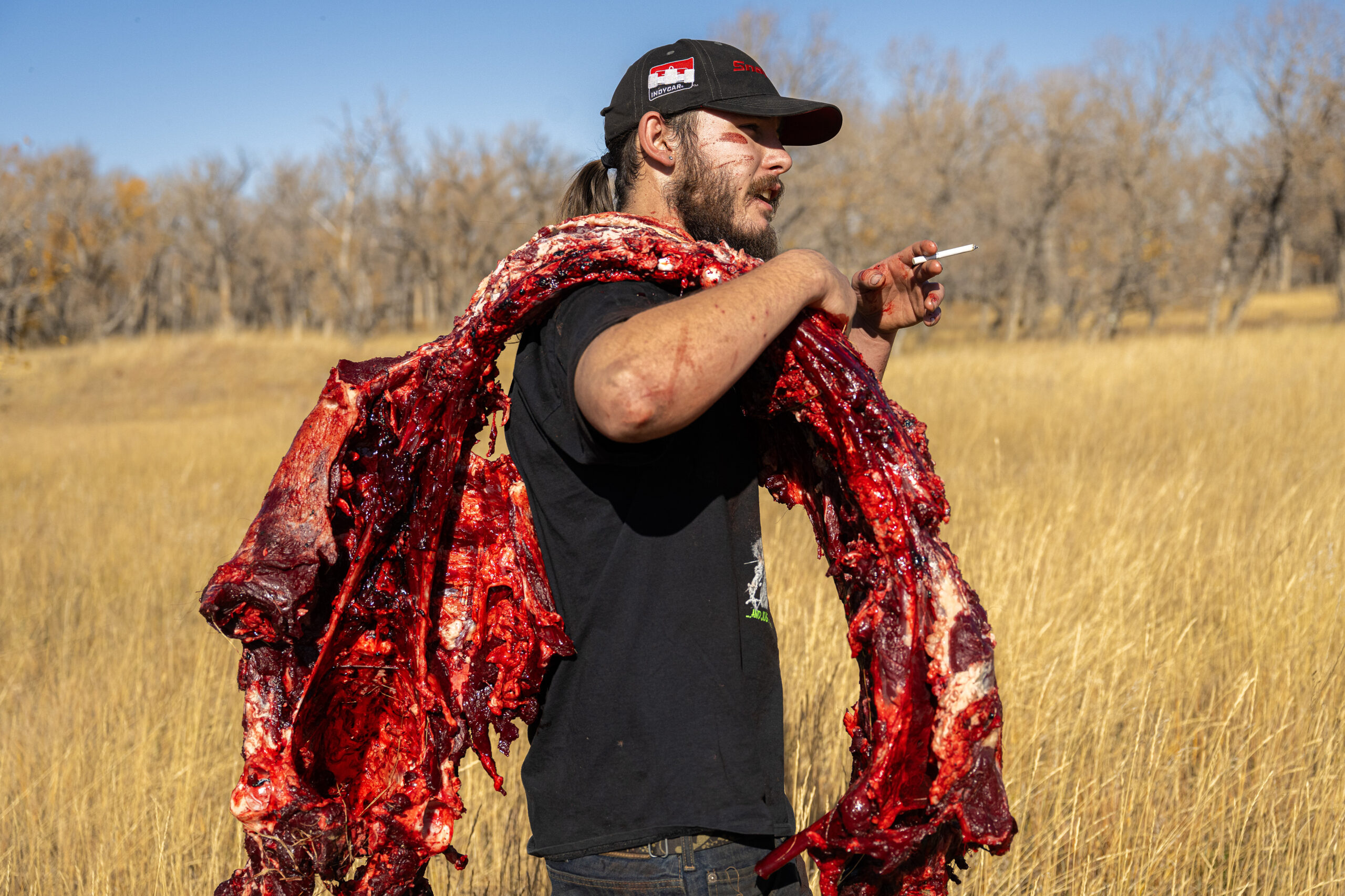
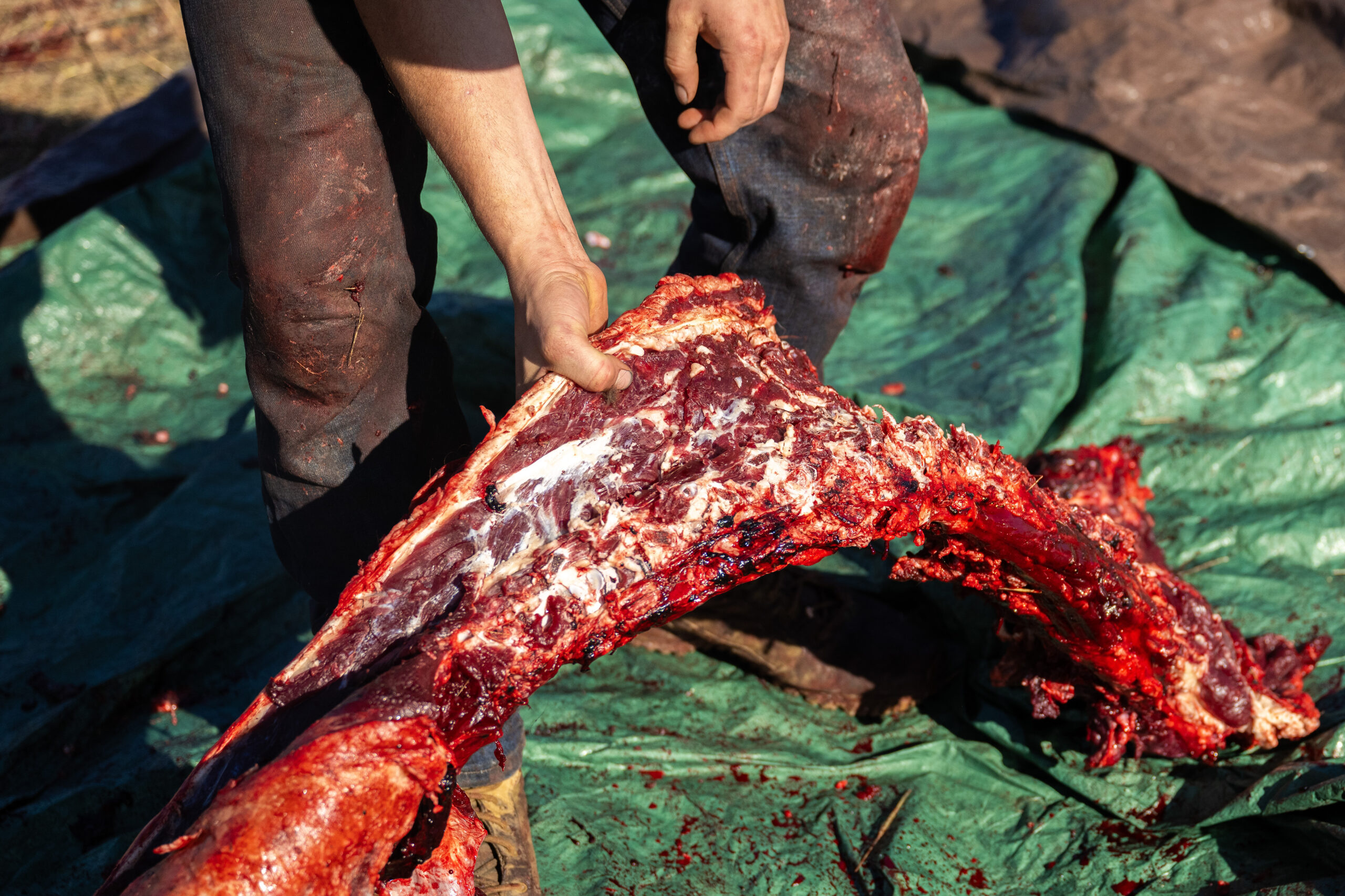
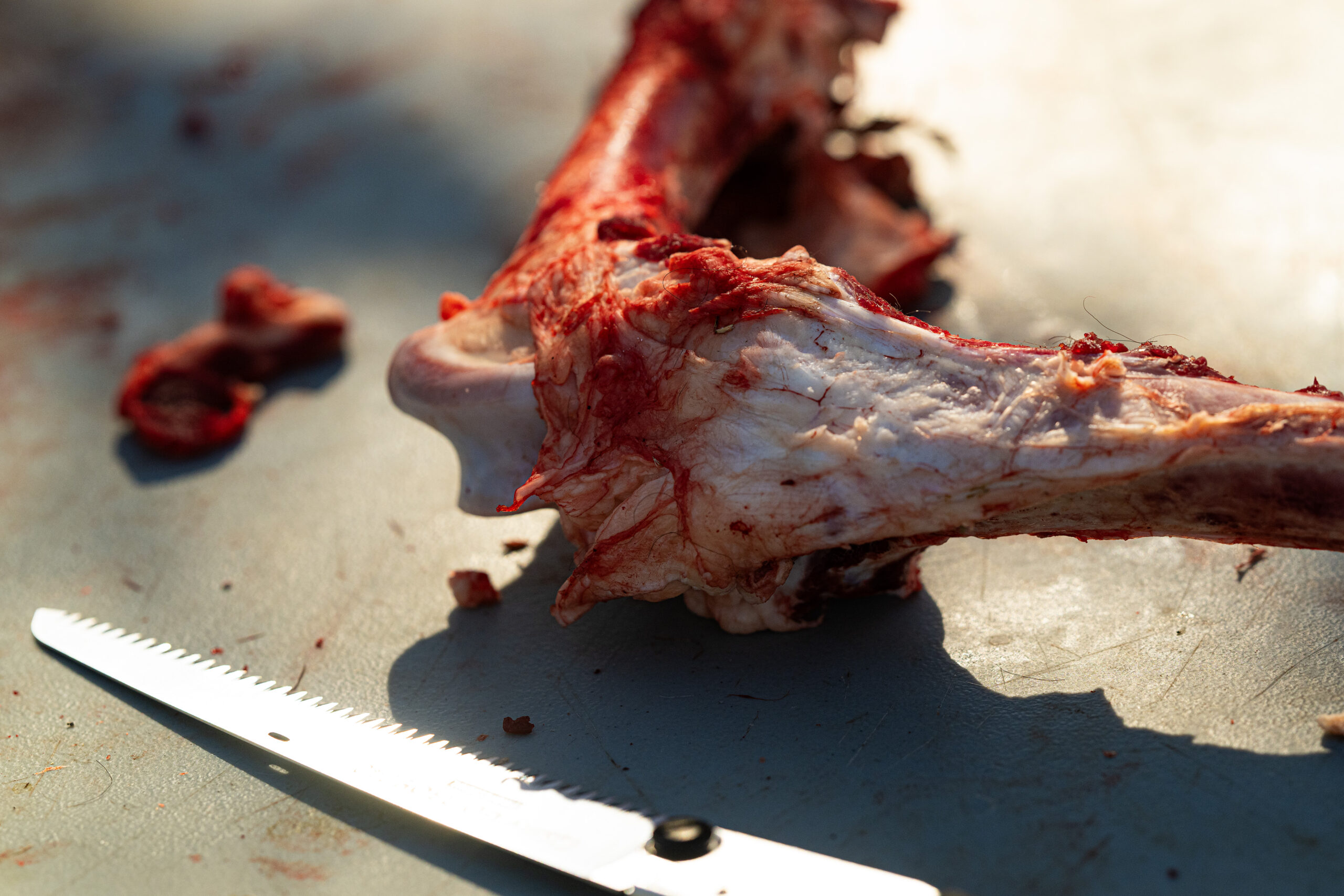
A crowd of maybe 250 middle- and high-school students from the Kainai Nation gathered to witness the harvest. The buffalo was butchered on a tarp in the middle of the field as the excited students looked on, getting their hands and clothes bloody as they passed around a heart roughly the size and shape of a football.
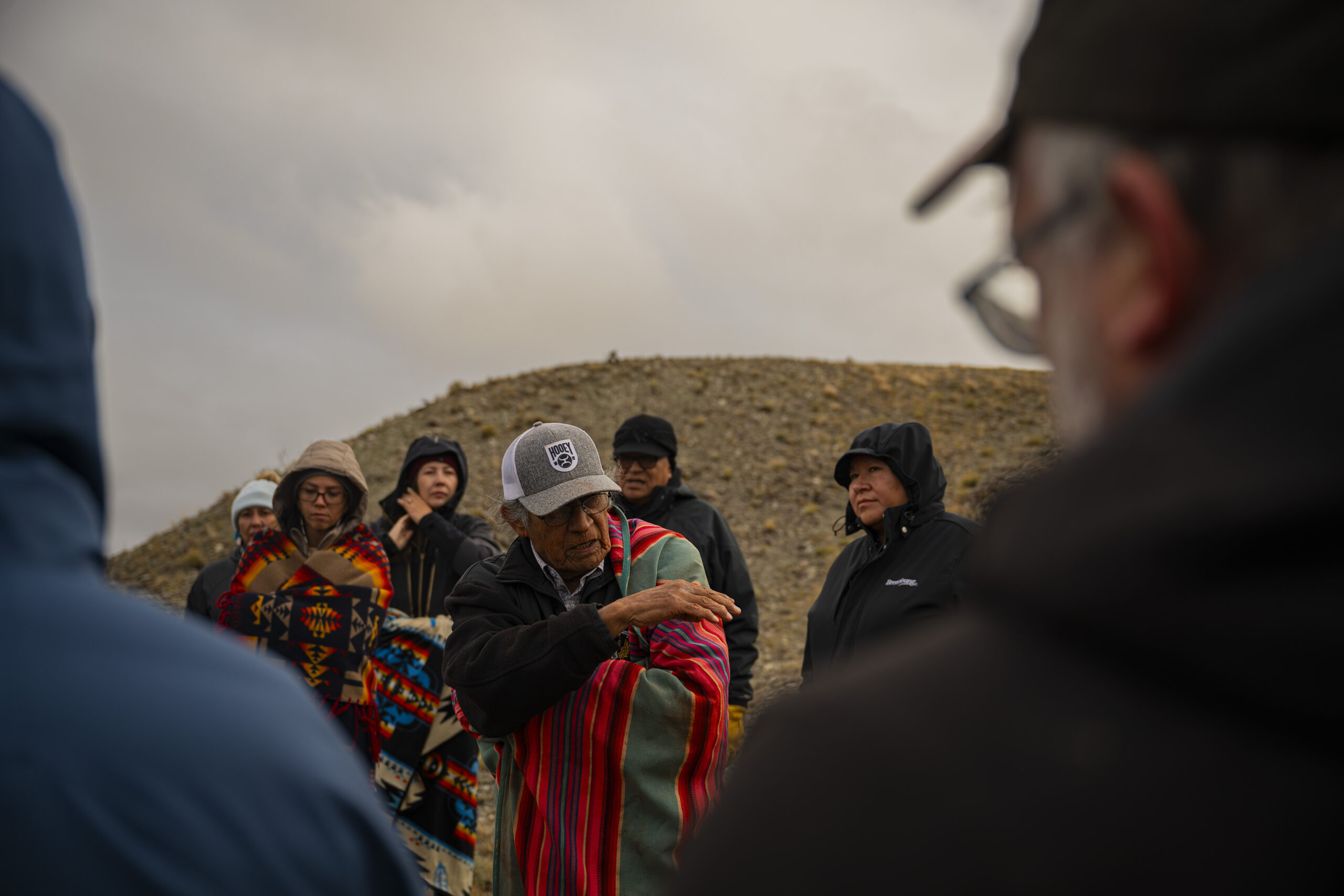
Tim Bruised Head, who led the harvest ceremony, brought his own young kids as well. He sees the harvest as an essential part of Blackfoot youth developing an understanding of their own identity.
“It’s dropping the pebble in the pond,” Bruised Head explains. “It has to start somewhere.”
The Blackfeet intention to build toward a traditional buffalo hunt — using a buffalo jump — comes as a surprise to the Kainai Guardians and Bruised Head. But each of them responds with a slight smile and a faraway look.
“That would be something to see,” Bruised Head says.
First Rider echoes his sentiment. “That’s the dream, right? To be able to participate in an actual buffalo jump,” he says. “That’s reigniting that relationship.”
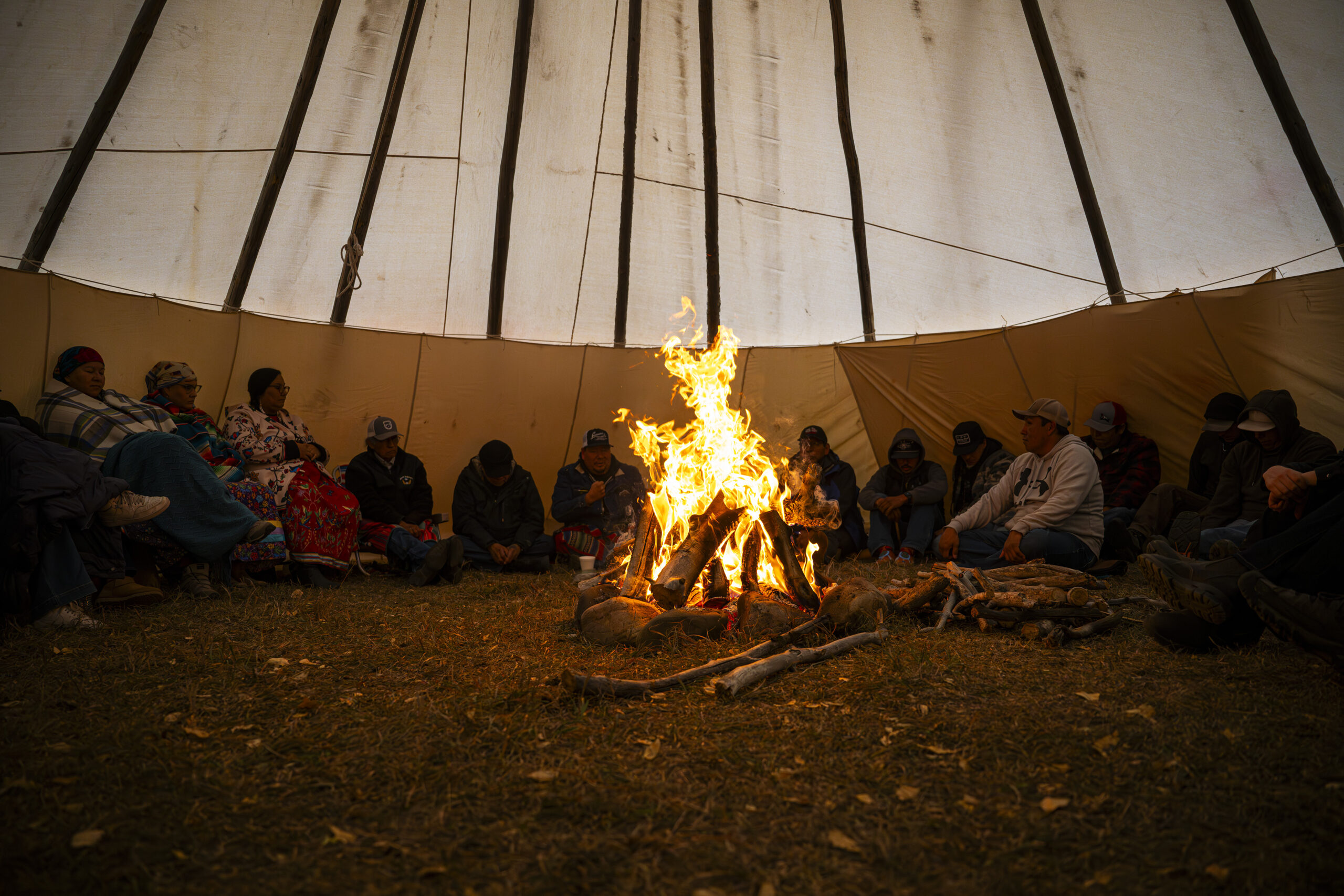
Back in Montana, a cold front has moved in, bringing freezing rain that patters on the tipi. But the couple dozen people seated around the fire inside are cozy as they take part in a ceremony as old as time.
A pipe is packed; prayers are recited; stories are told about the buffalo that fed, clothed, sheltered and supplied the Blackfoot until the overlapping calamities of colonization shattered Blackfoot culture.
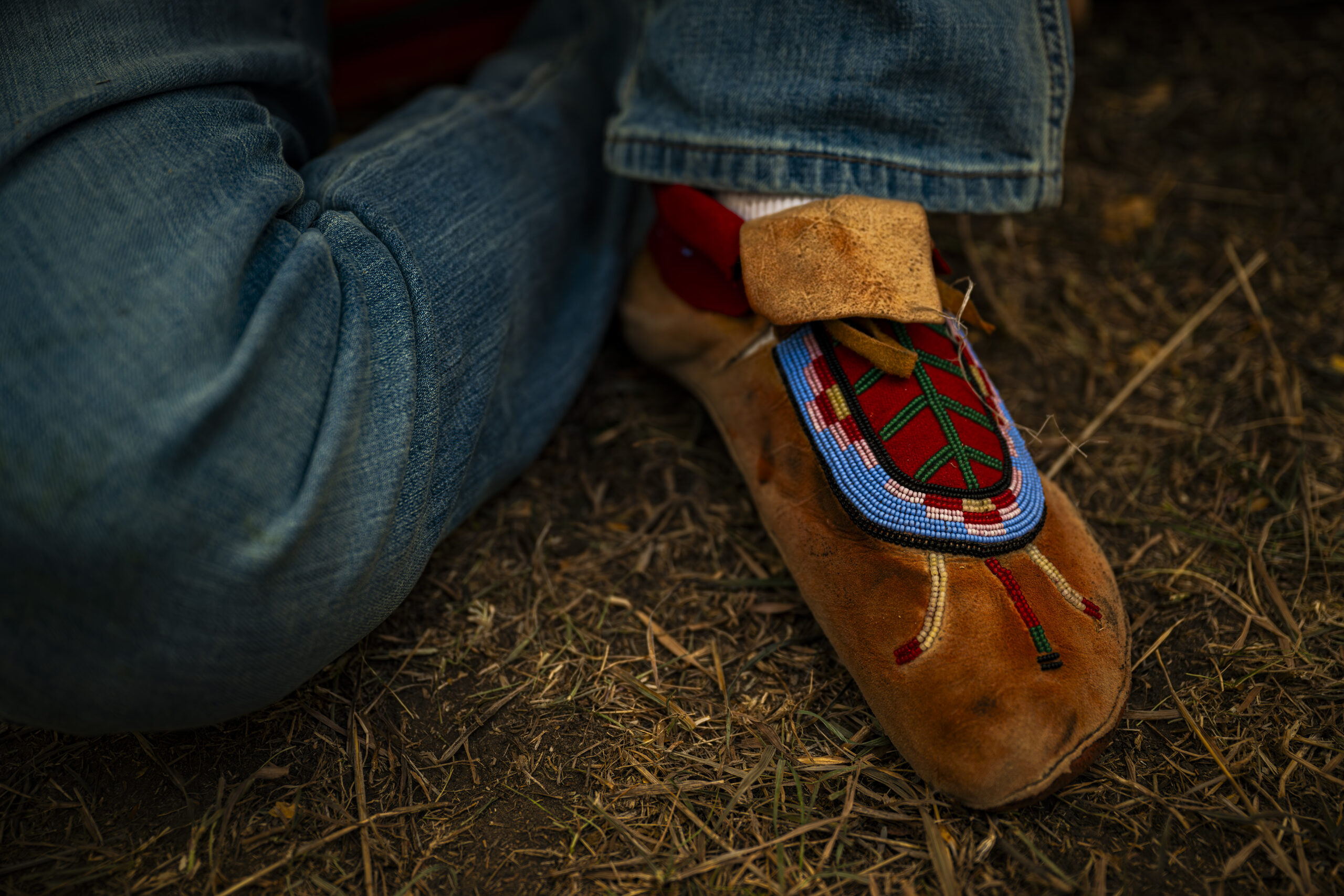
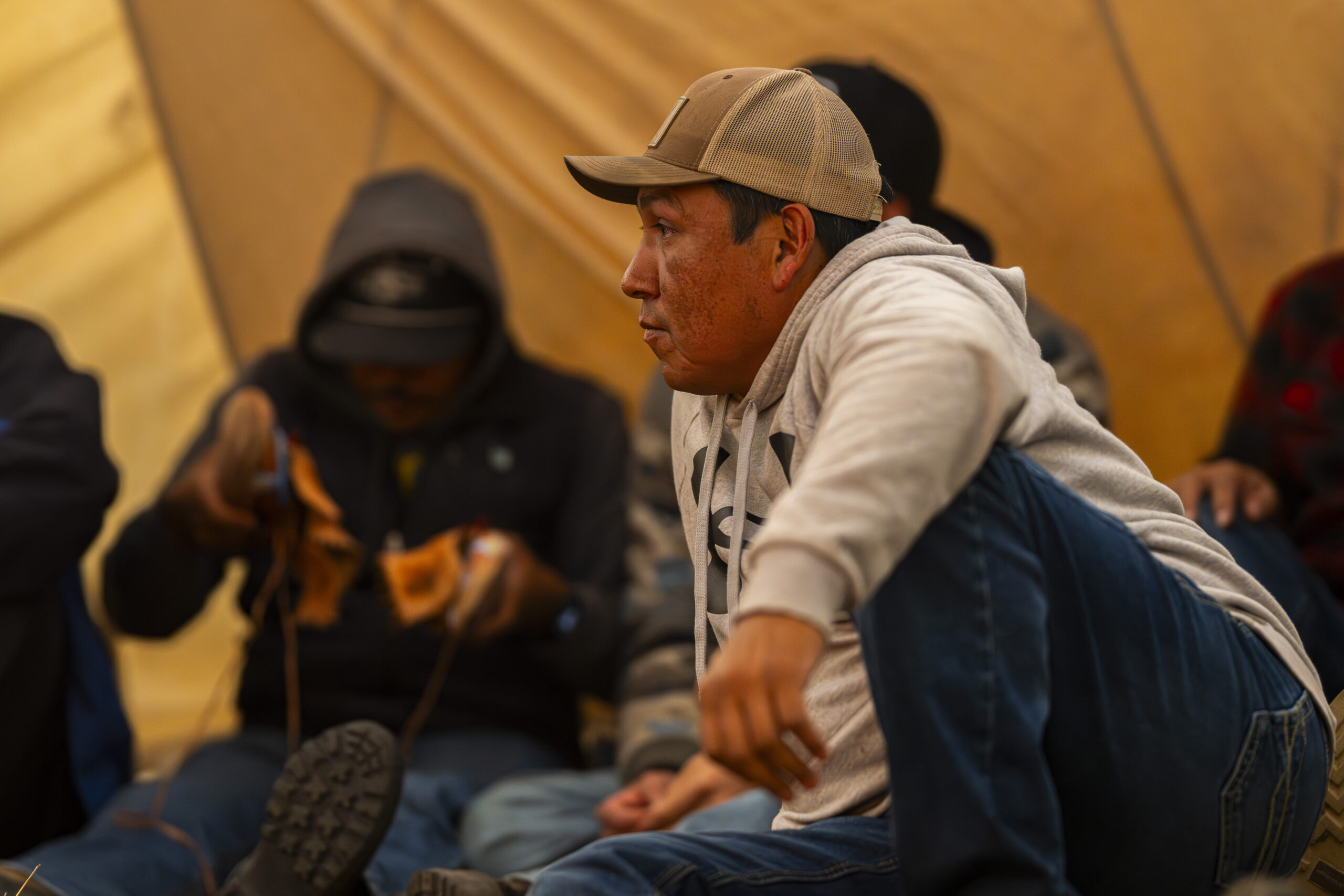
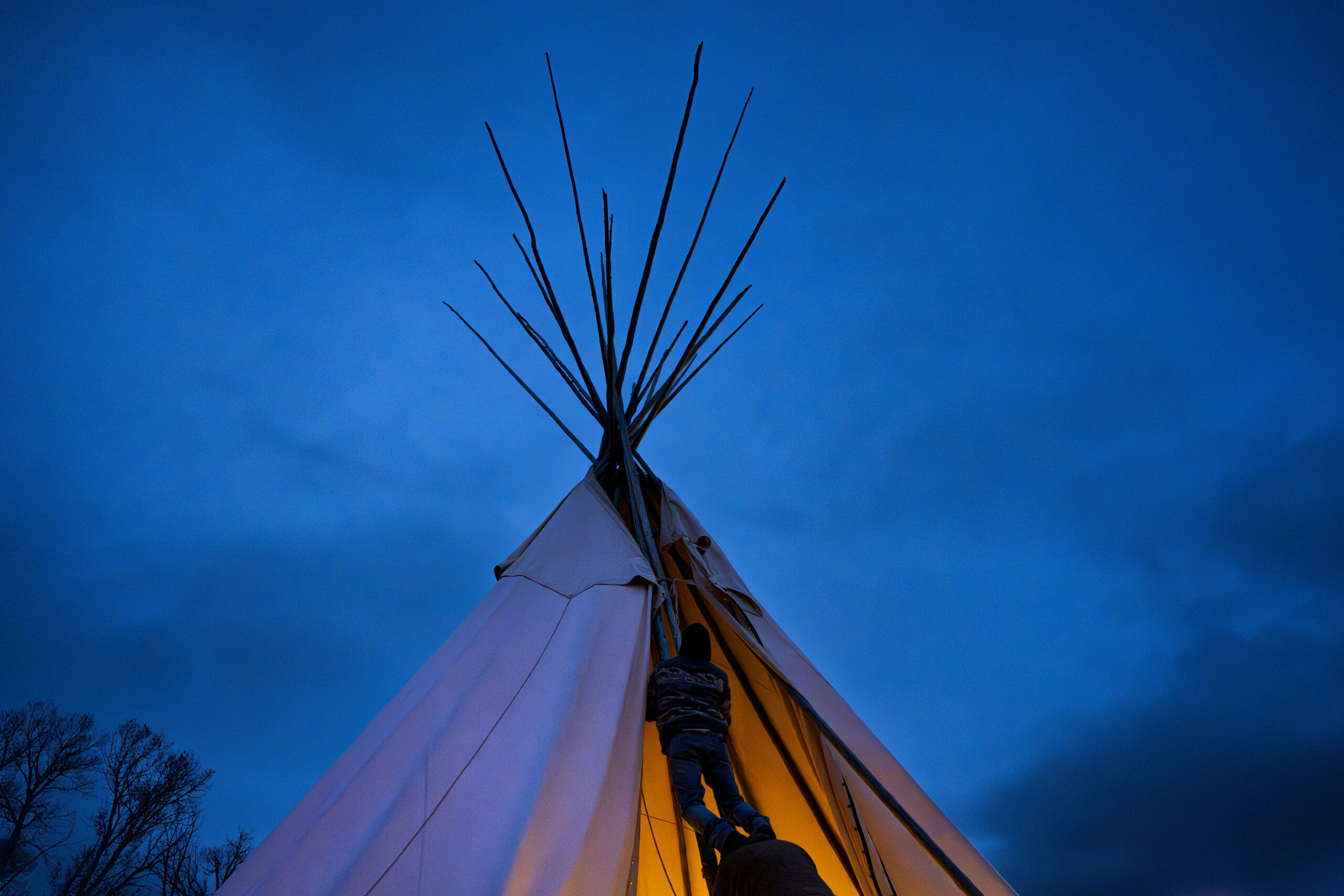
“Our way of life is like a puzzle,” Kent Ayoungman explains. He’s travelled from the Blackfoot member nation of Siksika in Alberta for the gathering here. “Some of it is intact, but most of it is scrambled.”
Ceremonies like this are part of the process of putting that puzzle back together. The pieces are coming back together through these ceremonies, through Elders’ closely held knowledge, through scientific observation on the land, through unique funding mechanisms and cross-border collaborations — and maybe, one day, through the herd rumbling up the prairie, guided by the Blackfoot toward a buffalo jump.
The fieldwork for this story was supported by a grant from the Yellowstone to Yukon Conservation Initiative. As per The Narwhal’s editorial independence policy, no foundation or outside organization has editorial input into our stories.
Updated Jan. 13, 2025 at 11:11 a.m PT: This story has been updated with additional context about The Nature Conservancy.
Get the inside scoop on The Narwhal’s environment and climate reporting by signing up for our free newsletter. On March 17, federal Conservative Leader Pierre Poilievre...
Continue reading
An internal document obtained by The Narwhal shows how the natural resources minister was briefed...

Notes made by regulator officers during thousands of inspections that were marked in compliance with...

Racing against time, dwindling habitat and warming waters, scientists are trying to give this little-known...
